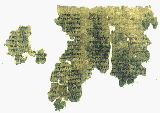
1 Enoch Fragment: Qumran library
When Bedouin shepherds happened upon earthen clay jars filled with ancient scrolls and fragments of scrolls west of the Dead Sea, they scarcely imagined the light that these relics would cast upon the Holy Scriptures (25,000 fragments).
The Dead Sea Scrolls (DSS) have contributed to a greater understanding of the prominence of Hebrew as a community language. The Manual of Discipline (Community Rule) scroll is written in Hebrew to inform the members of the strict Qumranite sect of community expectations. One would expect community rules to be written in the language of that community. The scrolls also illuminate, among other things, streams of Jewish thought and Hebraisms that appear in the New Testament. “Son of Man” and “sons of light” are oft terms.

Dead Sea, Israel
Last week, I introduced biblical and extra-biblical quotes that join centuries of Jewish ideas. This week, I will detail the “Son of Man/God” motif, continuing the effort to defend a New Testament Judaism. If you will remember, Bruce Chilton and Jacob Neusner pointed out key points that identify a first-century Jewish sect [1]:
“A Judaism” within a Judaic system appeals to its social order as Israel: “Now as many as live by this rule—shalom and mercy on them and the Israel of God” (Gal. 6:16, TLV).
A group that is situated in a Judaic system uses Torah’s text to argue for “Torah” as a way of life: “Do we then nullify the Torah through faithfulness? May it never be! On the contrary, we uphold the Torah” (Rom. 3:31 TLV).
A group functioning within the Judaic system will link their theology to the Torah through interpretations, rites, and actions: “Therefore, I judge not to trouble those from among the Gentiles who are turning to God—but to write to them to abstain from the contamination of idols, and sexual immorality, and from what is strangled, and from blood. For Moses from ancient generations has had in every city those, who proclaim him since he is read in all the synagogues every Shabbat” (Acts 15:19-21 TLV). Moses taught the Israelites, saying, “Any person from the children of Israel, or from the outsiders dwelling among them, who hunts as game any animal or bird that may be eaten, must drain its blood and cover it with dust. For the life of every creature, its blood is in its life. Therefore I said to the children of Israel: ‘You are not to eat the blood of any kind of creature, for the life of every creature is its blood’” (Lev. 17:13-14 TLV). This teaches Gentiles to live “jewishly” though they are not Jewish, and Acts 15 explains the expectations.
Hebraisms are words or phrases indicative of the Hebrew culture, even though they may be written in a different language. We might categorize “Son of Man” or “Son of God” as Hebraisms, noting their use in DSS literature. Also, Hebraic formulae appear in these texts. These are patterns of speech that Hebrew thinkers commonly use. For example, “you have heard it said/written” is a typical introductory formula in Jewish literature. The “Sermon on the Mount” is a great example, and I am sure we can recall Paul’s use of this introduction as he worked within Torah to explain gentile inclusion. Jesus is famous for using rabbinic argumentation, “if…then how much more,” to establish halakhic priority (practical law).
Like “Son of Man” or “Son of God,” “lake of fire,” “final judgment, ”book of life,” and “the books were opened” are all phrases found in the Jewish Pseudepigraphal book of 1 Enoch written before the time of Jesus. The “Son of Man” phrase is used extensively in 1 Enoch (chpts. 37-71 Parables) and throughout the Gospels and is said by some to be Jesus’ favored personal appellation. In 1 Enoch, the Son of Man is the Messiah who is given authority before creation by the Ancient of Days.
“And at that hour, the Son of Man was named in the presence of the Lord of Spirits, and his name before the Head of Days … he shall be the light of the nations … hope for those whose hearts are troubled” (1 Enoch 48:2, 3b, 4a, 3c.BCE-1c. CE).
“He (Son of Man) shall hurl kings from their thrones and their dominions because they will not exalt and praise him nor humble themselves before him by whom their kingdoms were granted” (1 Enoch 46:4).
“Behold, a wind arose from the sea and stirred up all its waves. And I looked, and behold; this wind made something like the figure of a man come up out of the heart of the sea. And I looked, and behold, that man flew with the clouds of heaven…” (4 Ezra 13, 1c. CE)
“For I (“angel of the presence”) have written this in the book of the first law, in which I wrote for you that you are to celebrate it (feasts) at each of the times one day in a year” (emphasis added for clarity, Jubilees 6:22).
The angel is compared to Enoch’s “son of man” and is explicitly mentioned in Exodus 23:20 as the angel who bears God’s name: “Behold, I send an angel before you (פנים מלאך) to guard you on the way and to bring you to the place that I have prepared. Pay attention to him and obey his voice; do not rebel against him, for he will not pardon your transgression, for my name is in him” (Exod. 23:20-21). This angel is endowed with the name of God, has judgment in his hands, and is to be obeyed. These attributes are commensurate with those delegated to the “Son of Man” in 1 Enoch.
We know that the Hebrew Scriptures (OT) is a Jewish work. Likewise, we understand that Jewish Pseudepigrapha and Apocrypha, like 1 Enoch, 4 Ezra, and Jubilees, are Second Temple Jewish texts like most of the New Testament—certainly the Gospels. All exhibit corroborating accounts of the “Son of Man” (Messiahship: divinely pre-existent yet human) with Daniel 7 images, as we saw last week. Therefore, these texts aid modern Christianity’s understanding, making the connection that the thoughts and theologies of the New Testament extend the Hebrew narrative.
While it is true that the New Testament is handed to us in the Greek language, the stream of conversations flowing down the centuries, asking similar questions of the Scriptures while arriving at interpretations formed within their Judaic sect, the Church benefits from re-reading the New Testament in a similar vein—a Second Temple Jewish text.

Photo by Em bé khóc nhè on Unsplash
“Sing to God, make music to His Name, extol the One Who rides upon the highest heavens, with Yah His Name and exult before Him” (Ps. 68:5 Schottenstein, Artscroll).
[1] Chilton, Bruce and Neusner, Jacob, “Introduction” in Judaism in the New Testament: Practices and Beliefs (Routledge: New York, 1995), xv.
